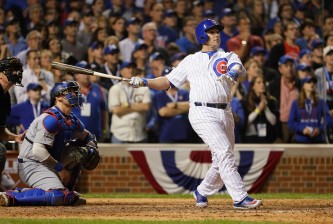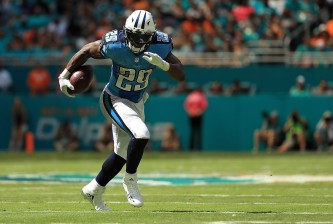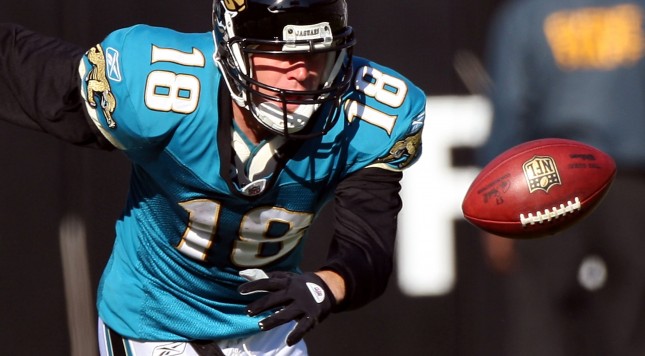Watching the stocks of 2016 NFL draft prospects rise and fall this week will be like watching a ticker on Wall Street.
The NFL Scouting Combine begins Tuesday at Indianapolis, and it’s a safe bet that a player or two will climb up draft boards because of his 40-yard dash time, number of bench-press reps or vertical leap.
Even if their game tape isn’t that impressive, these workout warriors tend to be overdrafted and fail to live up to the hype in the NFL.
This list of the 10 biggest combine busts of all-time should serve as a lesson to GMs and scouts everywhere. But it probably won’t.
(Combine results are from NFLCombineResults.com unless otherwise noted.)
No. 10: John Engelberger
It’s difficult to label a player who lasted nine years in the NFL a bust, but unless you’ve been watching games in a 49ers or Broncos man cave for the last decade or so you probably don’t remember the name John Engelberger.
The 6’4″, 268-pound defensive end entered the combine with a mid-round grade, but boosted his stock by beating all the other defensive ends with a 6.95-second three-cone drill and also making the top five in the 40 (4.73), vertical leap (34 inches) and broad jump (115 inches).
The 49ers took Engelberger in the second round, with the 35th overall pick, in the 2000 draft. Engelberger spent five years in San Francisco, with a career-high six sacks in 2004. He then played four years in Denver but recorded just three sacks in those four years. He finished his career with 20.5 sacks.
Perhaps Engelberger would have gained some notoriety if he were a classic bust, but he was “just another guy” for nine years and not worthy of an early second-round pick.
No. 9: Margus Hunt
Not many NFL players are 6’8″ and even fewer are from Estonia.
Margus Hunt checks both of those boxes, and he checked plenty of boxes at the 2013 combine. But those check marks have been fewer and farther between so far in his career with the Bengals.
Hunt came to SMU as a shot put and discus star and only began playing football in college. Perhaps that track and field background helped him at the combine, which is often called the “Underwear Olympics.”
The 277-pound Hunt bench pressed 225 pounds 38 times, tying him for the overall top spot. He was the fourth-fastest defensive end with a 4.62 40 and also fourth at the position with a 34.5-inch vertical leap.
The Bengals drafted Hunt in the second round, 53rd overall, but he hasn’t proven worthy of a second-round investment. He has yet to start a game in three seasons and he’s totaled just seven tackles and 1.5 sacks.
Hunt already was 26 when he entered the league, so he’s running out of time to shed the “combine tease” label.
No. 8: Darrius Heyward-Bey
The most impressive line on Darrius Heyward-Bey’s resumé at Maryland was third in the ACC with 694 receiving yards in 2006, his freshman season. He caught 42 passes for 609 yards and 14.5 yards per catch in 2008, the lowest in his three years at Maryland in all three categories.
The Terrapin was anything but turtle-like at the combine, however, leading all prospects with a 4.25 40-yard dash. He remains tied for fifth among all 40-yard dash participants since 1999.
Heyward-Bey’s combine performance shot him up the draft board and the speed-enchanted Raiders took him with the seventh overall pick in the 2009 draft. His career got off to a slow start and so far it has peaked with his 64 catches for 975 yards and four touchdowns in 2011.
Heyward-Bey’s career hasn’t justified the No. 7 pick. He has 193 career receptions. Michael Crabtree, chosen three picks later, has 432. But the 28-year-old caught 39 passes in 2015 and filled his role nicely as the Steelers’ fourth receiver. He’s also kept his career going by learning to play special teams. That sets him apart from other flashes in the combine pan and keeps him from being ranked too high on this dubious list.
No. 7: Fabian Washington
Fabian Washington would have won the bronze in 2005 if medals were awarded at the combine because his 4.29 was the third-fastest overall time in the 40. He also made the top 10 with a 41.5-inch vertical leap and his 18 bench-press reps tied for fifth among cornerbacks.
In three years at Nebraska, Washington had a so-so 11 interceptions. But not surprisingly, his speed turned the Raiders’ heads and they took him with the 23rd pick in the draft.
Washington’s best year was 2006, when he intercepted four passes and broke up 15. He had only two more interceptions in his career, however. The Raiders traded him to the Ravens after the 2007 season. He was benched multiple times in Baltimore and his 2009 season ended when he tore his ACL.
After starting eight games for the Ravens in 2010, Washington signed with the Saints in 2011 but suffered a hamstring injury that essentially ended his career.
Washington has the distinction of being the last guy drafted before Aaron Rodgers. That was OK, though, because the Raiders drafted JaMarcus Russell two years later.
No. 6: Tye Hill
An All-American at Clemson in 2005, Tye Hill was among the top five cornerbacks in the 40, vertical leap, broad jump and shuttle at the 2006 combine. He was the fastest cornerback in the three-cone drill.
This impressed the Rams enough to make him the 15th player off the board in the 2006 draft. Hill showed promise as a rookie. He started 10 games, intercepted three passes and broke up six. He had just two interceptions in the next four years, however, and the injury-prone corner started fewer and fewer games every season. He went from seven starts in 2007 to four in 2008 to three in 2009 to one in 2010.
The Rams traded Hill to the Falcons in 2009, and Hill earned the distinction of allowing more pass plays of 20 or more yards than anyone in the league.
Hill’s career ended with the Lions in 2010. Meanwhile, Johnathan Joseph has just completed his 10th season, two of which earned him Pro Bowl honors. He was drafted nine spots after Hill.
No. 5: Mike Mamula
Mike Mamula is the poster child for combine freaks who didn’t live up to their draft position in the NFL. He blazed that infamous trail when he tore up the 1995 combine and went from a second- or third-round grade to the seventh overall pick.
Mamula benched 28 times, which would have ranked him third in the linebacker category in 2015, according to NFL.com. His 4.58 40 and 38.5-inch vertical leap would have placed him fifth at the position last season.
While Mamula pioneered the trend of training specifically for the combine and later became synonymous with combine busts, his case is far from the worst because he didn’t have an awful career.
Mamula remained an Eagle, going from Boston College to Philadelphia, and as a 6’4″, 252-pound defensive end recorded 31.5 sacks in a five-year career that was cut short by injuries. Mamula had eight sacks in 1996 and forced three fumbles, returning one for a touchdown. He missed the 1998 season with a knee injury but came back in 1999 with 8.5 sacks and again forced three fumbles. Mamula hung it up after an injury-riddled 2000 season.
Perhaps Mamula would have been more effective as a linebacker in the NFL. Taking on offensive tackles off the snap was hard on the undersized Mamula, and history has been even harder on him.
No. 4: Chris Henry
It took Chris Henry four years to rush for 892 yards at Arizona, and he averaged just 3.3 yards per carry in those four years. In 2006, his senior season, Henry ran for 581 yards, 11th in the Pac-10. His 3.5 yards per carry were 19th in the conference.
Despite those unimpressive numbers, Henry was at the head of the running back class in the 40-yard dash at the 2007 combine, timing 4.40. He matched Adrian Peterson’s time, but at 230 weighed 13 more pounds.
Henry also tied for third among running backs with 26 reps in the bench press and tied with Peterson atop the position group with a 127-inch broad jump.
The similarities with Peterson ended there.
The Titans chose Henry in the second round with the 50th pick, but he was suspended for four games in his rookie season for violating the NFL’s substance abuse policy. He appeared in only 11 games in a four-year career that ended with a season in Seattle. He carried the ball 32 times in the NFL for 122 yards.
No. 3: Troy Williamson
Troy Williamson’s 4.32-second 40-yard dash at the 2005 combine was enough to convince the Vikings that he could replace Randy Moss, who was traded to the Raiders after the 2004 season.
The Vikings received the seventh overall pick in the deal and used it to draft Williamson out of South Carolina, passing on the more highly touted Mike Williams of USC.
Williams was largely a disappointment but still caught 127 passes in his career to Williamson’s 87. Infamous for dropping passes, Williamson peaked at 37 receptions for the Vikings in 2006. After three ineffective years in Minnesota, Williamson was traded to the Jaguars. He caught just eight passes in two years at Jacksonville and 2009 turned out to be his last season.
Williamson cracks the top three on this list because of how high he was drafted. He’s the biggest bust of the three players on this list who were drafted seventh overall.
No. 2: Matt Jones
Matt Jones broke the SEC rushing record for quarterbacks with 2,545 yards at Arkansas, but because of shoulder problems NFL scouts tabbed him as a receiver.
Jones showed he had receiver’s speed at the 2005 combine. The 6’6″, 242-pounder ran a 4.37 40-yard dash. No one at that height or weight has run that fast in the 40 before or since. His 129-inch broad jump was tied for seventh overall.
Chris Mortensen of ESPN said at the time that Jones was “the best player in the draft.” Jones was projected as a fourth-round pick early in the draft process but skyrocketed to the first round, where he was chosen 21st by the Jaguars.
Jones caught 166 passes in four years, including a career-high 65 in 2008. But he was arrested that year for cocaine possession and booked again for testing positive for alcohol and therefore violating his probation a year later. Jones was suspended for the final three games of the 2008 season for violating the league’s substance abuse policy and cut in March. He never played in the NFL again.
One of the reasons Aaron Rodgers’ wait in the green room was so infamously long is that Jones was chosen three picks ahead of him. The Jaguars also had Roddy White, Heath Miller and Logan Mankins available to them when they picked Jones.
Even though Jones had his moments, he’s second on this list because of just how gaudy his combine numbers were and the degree to which he had the Jaguars fooled.
No. 1: Vernon Gholston
Vernon Gholston had 14 sacks at Ohio State in 2007, third in the NCAA, then dominated across the board at the 2008 combine. He and offensive tackle Jake Long tied for first overall with 37 reps in the bench press. Gholston was tops among defensive ends in the 40-yard dash (4.65), vertical leap (35.5′) and broad jump (125 inches).
That was as impressive as Gholston’s numbers would get.
Gholston didn’t start playing football until his sophomore year in high school and was generally seen as a raw talent. At least one team had a third-round grade on him, but the Jets drafted the 6’4″, 258-pounder sixth overall and he turned out to be the biggest combine bust of all-time. Gholston started five games in three seasons and made 16 tackles with no sacks.
The Jets released Gholston after the 2010 season. He couldn’t make it out of training camp with the Bears in 2011 or the Rams in 2012. It’s been more than five years since Gholston played his last NFL game and he’s not yet 30.


























